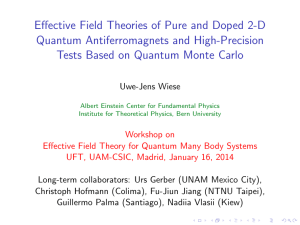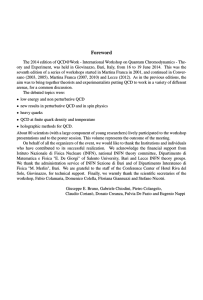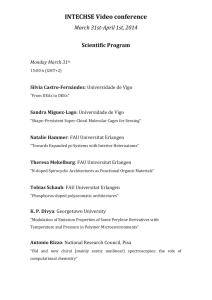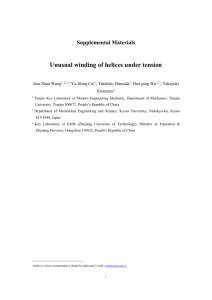Effective Field Theories for Doped Antiferromagnets
advertisement
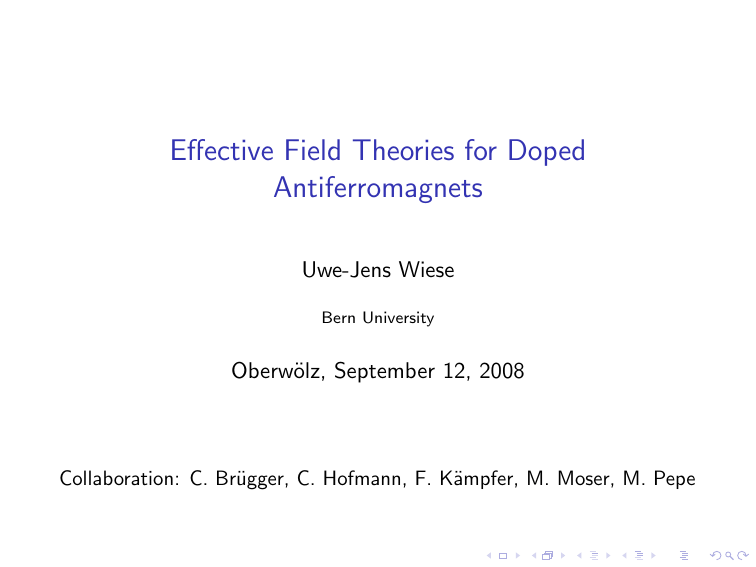
Effective Field Theories for Doped Antiferromagnets Uwe-Jens Wiese Bern University Oberwölz, September 12, 2008 Collaboration: C. Brügger, C. Hofmann, F. Kämpfer, M. Moser, M. Pepe Outline Cuprates Correspondences between QCD and Antiferromagnetism Models for Doped Antiferromagnets Effective Field Theory for Magnons Effective Field Theory for Magnons and Holes Magnon-mediated Two-Hole Bound States Spiral Phases of the Staggered Magnetization Chiral Spiral and Pion Condensation Conclusions Outline Cuprates Correspondences between QCD and Antiferromagnetism Models for Doped Antiferromagnets Effective Field Theory for Magnons Effective Field Theory for Magnons and Holes Magnon-mediated Two-Hole Bound States Spiral Phases of the Staggered Magnetization Chiral Spiral and Pion Condensation Conclusions Antiferromagnetic precursors of high-Tc superconductors LaCuO YBaCuO Properties of cuprates Temperature-dependence of resistivity Outline Cuprates Correspondences between QCD and Antiferromagnetism Models for Doped Antiferromagnets Effective Field Theory for Magnons Effective Field Theory for Magnons and Holes Magnon-mediated Two-Hole Bound States Spiral Phases of the Staggered Magnetization Chiral Spiral and Pion Condensation Conclusions Phase diagrams of QCD and of doped antiferromagnets QCD phase diagram Phase diagram of cuprates Quark-gluon plasma T strange metal T hadronic phase color superconductor chemical potential antiferromagnetic phase high-temperature superconductor hole concentration Correspondences between QCD and Antiferromagnetism broken phase global symmetry symmetry group G unbroken subgroup H Goldstone boson Goldstone field in G /H order parameter coupling strength propagation speed conserved charge charged particle long-range force dense phase microscopic description effective description of Goldstone bosons effective description of charged fields QCD hadronic vacuum chiral symmetry SU(2)L ⊗ SU(2)R SU(2)L=R pion U(x) ∈ SU(2) chiral condensate pion decay constant Fπ velocity of light baryon number U(1)B nucleon or antinucleon pion exchange nuclear or quark matter lattice QCD chiral perturbation theory baryon chiral perturbation theory Antiferromagnetism antiferromagnetic phase spin rotations SU(2)s U(1)s magnon ~e (x) ∈ S 2 staggered magnetization spin stiffness ρs spin-wave velocity c electric charge U(1)Q electron or hole magnon exchange high-Tc superconductor Hubbard or t-J model magnon effective theory effective theory presented here Outline Cuprates Correspondences between QCD and Antiferromagnetism Models for Doped Antiferromagnets Effective Field Theory for Magnons Effective Field Theory for Magnons and Holes Magnon-mediated Two-Hole Bound States Spiral Phases of the Staggered Magnetization Chiral Spiral and Pion Condensation Conclusions The Hubbard model on the square lattice H = −t X (cx† cy + cy† cx ) +U X (cx† cx 2 − 1) , cx = x hxy i cx↑ cx↓ U(1)Q and SU(2)s symmetries Q= X (cx† cx − 1), ~S = X x cx† x ~σ cx , 2 [H, Q] = [H, ~S] = 0 The t-J model H=P −t X (cx† cy + cy† cx ) +J hxy i X ~Sx · ~Sy P hxy i reduces to the Heisenberg model at half-filling H=J X hxy i ~Sx · ~Sy Outline Cuprates Correspondences between QCD and Antiferromagnetism Models for Doped Antiferromagnets Effective Field Theory for Magnons Effective Field Theory for Magnons and Holes Magnon-mediated Two-Hole Bound States Spiral Phases of the Staggered Magnetization Chiral Spiral and Pion Condensation Conclusions Effective Goldstone boson field in SU(2)/U(1) = S 2 ~e (x) = (e1 (x), e2 (x), e3 (x)), ~e (x)2 = 1 Transformation rules of magnon fields ~e (x)0 = R~e (x), SU(2)s : Di : Di ~e (x) = −~e (x), O: O ~e (x) = ~e (Ox), Ox = (−x2 , x1 , t), R: R ~e (x) = ~e (Rx), Rx = (x1 , −x2 , t), T : T ~e (x) = −~e (Tx), Tx = (x1 , x2 , −t) Low-energy effective action for magnons Z S[~e ] = ρs d x dt 2 2 1 ∂i ~e · ∂i ~e + 2 ∂t~e · ∂t~e c Fit to predictions in the ε-regime of magnon chiral perturbation theory with βc ≈ L, l = (βc/L)1/3 M2s L2 β χs = 3 2ρs χu = 2 3c 2048 ( 1 c e 1 1+ β1 (l) + 3 ρs Ll 3 c ρs Ll c ρs Ll ) 2 β1 (l) + 3β2 (l) Q/J = 0.1 Q/J = 0.5 Q/J = 1 Q/J = 2 Q/J = 3 Q/J = 4 64 1024 2 2 ) 1 βe2 (l) − βe1 (l)2 − 6ψ(l) 3 128 Q/J = 0.1 Q/J = 0.5 Q/J = 1 Q/J = 2 Q/J = 3 Q/J = 4 2 χSJa 4096 c 1+2 β1 (l) + ρs Ll < Wt > 8192 ( 32 16 8 512 4 256 32 64 32 L/a Ms = 0.3074(4)/a2 , 64 L/a ρs = 0.186(2)J, c = 1.68(2)Ja Nonlinear realization of the SU(2)s symmetry u(x)~e (x) · ~σ u(x)† = σ3 , u11 (x) ≥ 0 Under SU(2)s the diagonalizing field u(x) transforms as u(x)0 = h(x)u(x)g † , u11 (x)0 ≥ 0, exp(iα(x)) 0 h(x) = exp(iα(x)σ3 ) = ∈ U(1)s 0 exp(−iα(x)) The composite vector field vµ (x) = u(x)∂µ u(x)† = ivµa (x)σa , vµ± (x) = vµ1 (x) ∓ ivµ2 (x) transforms as vµ3 (x)0 = vµ3 (x) − ∂µ α(x), vµ± (x)0 = exp(±2iα(x))vµ± (x) Outline Cuprates Correspondences between QCD and Antiferromagnetism Models for Doped Antiferromagnets Effective Field Theory for Magnons Effective Field Theory for Magnons and Holes Magnon-mediated Two-Hole Bound States Spiral Phases of the Staggered Magnetization Chiral Spiral and Pion Condensation Conclusions Hole dispersion in the t-J model p2 π a π π a π /2 0 p1 -π /2 -π -π -π /2 π /2 0 π Hole pockets centered at lattice momenta kα = π π , , 2a 2a k α0 = −k α , kβ = π π , ,− 2a 2a 0 k β = −k β Hole fields 0 1 kf f kf ψ+ (x) = √ ψ+ (x) − ψ+ (x) , 2 0 1 kf f kf ψ− (x) = √ ψ− (x) + ψ− (x) 2 Transformation rules of fermion fields SU(2)s : f f ψ± (x)0 = exp(±iα(x))ψ± (x), U(1)Q : Q f f ψ± (x) = exp(iω)ψ± (x), Di : Di f f ψ± (x) = ∓ exp(ikif a) exp(∓iϕ(x))ψ∓ (x), O: O β α ψ± (x) = ∓ψ± (Ox), O R: R β α ψ± (x) = ψ± (Rx), R β α ψ± (x) = ψ± (Ox), β α ψ± (x) = ψ± (Rx) Leading terms in the effective Lagrangian for holes L = X h f f Mψsf † ψsf + ψsf † Dt ψsf + Λ ψsf † v1s ψ−s + σf ψsf † v2s ψ−s f =α,β s=+,− + i 1 1 f† f f† f f† f D ψ D ψ + σ D ψ D ψ + D ψ D ψ 1 2 2 1 i i f s s s s s s 2M 0 2M 00 Covariant derivative coupling to composite magnon gauge field f f Dµ ψ ± (x) = ∂µ ± ivµ3 (x) ψ± (x) Outline Cuprates Correspondences between QCD and Antiferromagnetism Models for Doped Antiferromagnets Effective Field Theory for Magnons Effective Field Theory for Magnons and Holes Magnon-mediated Two-Hole Bound States Spiral Phases of the Staggered Magnetization Chiral Spiral and Pion Condensation Conclusions Magnon exchange p~+ ′ p~− f− f+ ~q f˜− f˜+ ′ p~+ p~− One-magnon exchange potentials V αα (~r ) = γ sin(2ϕ) , r2 V αβ (~r ) = V βα (~r ) = γ sin(2ϕ) , r2 Λ2 γ= 2πρs V ββ (~r ) = −γ cos(2ϕ) , r2 Two-hole Schrödinger equation for an αβ pair − M1 0 ∆ V αβ (~r ) V αβ (~r ) − M1 0 ∆ Ψ1 (~r ) Ψ2 (~r ) =E Ψ1 (~r ) Ψ2 (~r ) Making the ansatz Ψ1 (~r ) ± Ψ2 (~r ) = R(r )χ± (ϕ) for the angular part of the wave function one obtains − d 2 χ± (ϕ) ± M 0 γ cos(2ϕ)χ± (ϕ) = −λχ± (ϕ) dϕ2 1 0.5 0 -0.5 -1 -3 -2 -1 0 j 1 2 3 The radial Schrödinger equation d 2 R(r ) 1 dR(r ) λ − + − 2 R(r ) = M 0 ER(r ) 2 dr r dr r is solved by the Bessel function R(r ) = AKν p M 0 |En |r , √ ν=i λ with the energy eigenvalue (for large n) √ En ∼ −(M 0 r02 )−1 exp(−2πn/ λ) Two-hole bound state of an αα pair 1 0.5 0 -0.5 -1 -1.5 -2 -3 -2 -1 0 1 2 3 ϕ e Angular wave function Probability density Outline Cuprates Correspondences between QCD and Antiferromagnetism Models for Doped Antiferromagnets Effective Field Theory for Magnons Effective Field Theory for Magnons and Holes Magnon-mediated Two-Hole Bound States Spiral Phases of the Staggered Magnetization Chiral Spiral and Pion Condensation Conclusions Spiral configurations vi3 (x)0 = vi3 (x) − ∂i α(x) = ci3 , vi± (x)0 = vi± (x) exp(±2iα(x)) = ci have a non-zero magnetic energy density m = ρs ∂i ~e (x) · ∂i ~e (x) = 2ρs vi+ (x)vi− (x) = 2ρs (c12 + c22 ) 2 Single-particle Hamiltonian H f (~p ) = M+ pi2 2M 0 + σf p1 p2 M 00 Λ(c1 + σf c2 ) Λ(c1 + σf c2 ) M+ pi2 2M 0 + σf p1 p2 M 00 yields energy values E±f (~p ) = M + pi2 p1 p2 + σf ± Λ|c1 + σf c2 | 0 2M M 00 Total density of fermions β β α α n = n+ + n− + n+ + n− Total energy density of holes h = α+ + α− + β+ + β− ! Stability range of various phases κ1 κ2 κ3 κ4 κi 0 0 1 Homogeneous phase Zero degree spiral 2 MeffΛ2/2πρs Inhomogeneous phase Compressibilities are given by Λ2 π Λ2 M 0 M 00 2π − , κ2 = − , Meff = p Meff 2ρs Meff 4ρs M 00 2 − M 0 2 1 Meff Λ2 π 2π 1− , κ4 = κ3 = 3Meff 2 6πρs − Meff Λ2 2Meff κ1 = Outline Cuprates Correspondences between QCD and Antiferromagnetism Models for Doped Antiferromagnets Effective Field Theory for Magnons Effective Field Theory for Magnons and Holes Magnon-mediated Two-Hole Bound States Spiral Phases of the Staggered Magnetization Chiral Spiral and Pion Condensation Conclusions Chiral spiral (with D. Arnold and G. Colangelo) U = cos α1 + i sin α [cos(ki xi )τ1 + sin(ki xi )τ2 ] = u 2 , 1 † 1 † 2 τ3 , u ∂i u + u∂i u = iki sin α − vi = 2 2 k 1 † i ai = u ∂i u − u∂i u † = sin 2α τ2 2i 2 Energy density of a spiral configuration SU(2) Fπ2 2 2 hψψi k 2 cos2 α k sin α + cos α(mu + md ) + MN + n 2 2 8MN gA |k| sin α (3π 2 )5/3 5/3 5/3 (n+ − n− ) + n + n , n = n+ + n− − 2 10π 2 MN + ε = + Critical baryon density for pion condensation nc ≈ (0.1GeV)3 ≈ nnuclear matter Outline Cuprates Correspondences between QCD and Antiferromagnetism Models for Doped Antiferromagnets Effective Field Theory for Magnons Effective Field Theory for Magnons and Holes Magnon-mediated Two-Hole Bound States Spiral Phases of the Staggered Magnetization Chiral Spiral and Pion Condensation Conclusions Conclusions • There are intriguing analogies between antiferromagnets and QCD. • Doped antiferromagnets are described by a systematic low-energy effective field theory analogous to chiral perturbation theory. • One-magnon exchange leads to two-hole bound states analogous to the deuteron. • Spiral phases in doped antiferromagnets are analogous to pion condensation in nuclear matter. • Electron-doped systems as well as systems with other lattice geometries have been studied with similar techniques. Some references B. I. Shraiman and E. D. Siggia, Phys. Rev. Lett. 60 (1988) 740 F. Kämpfer, M. Moser, and U.-J. Wiese, Nucl. Phys. B729 (2005) 317 C. Brügger, F. Kämpfer, M. Moser, M. Pepe, and U.-J. Wiese, Phys. Rev. B74 (2006) 224432 C. Brügger, F. Kämpfer, M. Pepe, and U.-J. Wiese, Eur. Phys. J. B53 (2006) 433 C. Brügger, C. P. Hofmann, F. Kämpfer, M. Pepe, and U.-J. Wiese, Phys. Rev. B75 (2007) 014421
